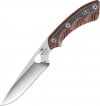- Joined
- Jun 9, 2011
- Messages
- 32,021
The propensity of an edge to roll is not determined by its sharpness, dullness, or how recently it has been restored. Rather the likeliness of new deformation will be determined by the number and strengths of fresh insults to the edge. When working with food (soft stuff), the edge will be fine until a bone is whacked. How hard is the bone? At what angle was it struck? How hard was the strike? How many times was it struck?
A dull edge will roll just as readily as a sharp one. Meat cleavers have obtuse edge angles in anticipation of bone strikes. Fine edged cutlery.. not so much.
yes Sir. I meant more the factory edge which was made using a belt sander and some heat that may or may not depending on who do the sharpening and how much heat got to the edge......compromise the steel...vs. sharpening and getting to new steel and how it holds up. we shall see if there is any effect or not in David's real world knife use testing.

